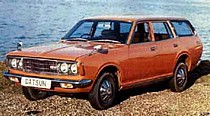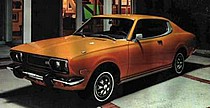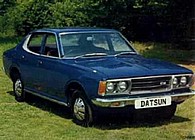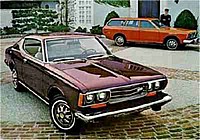
The 610 series was launched in Japan in August 1971 and was badged as the Datsun Bluebird-U. The meaning behind the U suffix is “User Oriented”, to signify the higher comfort levels than 510 predecessor could muster. A domestic advertising campaign used the catch-line “Bluebird U – Up You!”, and was short-lived due to the innuendo. The 610 was one of the first Nissan products to adopt a popular styling appearance, called “coke bottle” which appeared internationally during the 1960s and 1970s, an appearance shared with the larger Nissan Cedric, as both vehicles were available at Japanese Nissan dealerships called Nissan Bluebird Store.
The SSS hardtop coupe was the first Nissan to adopt the new bodystyle, and subsequent Nissan products soon offered the appearance in both 2- and 4-door versions for several decades.
For the Japanese domestic market, the 610 was pitted against the second generation Toyota Corona Mark II. Also in Japan, the 610 was initially sold alongside the 510 but eventually replaced the 510. 610s were available as a four-door, two-door hardtop, and a five-door wagon/light van. Trim levels in Japan were GL (Grand Luxe), SSS (Super Sports Sedan), DX (Deluxe) or STD (Standard). It borrowed its suspension and drive train from the outgoing 510, with some modifications. Likewise, the 610 four-door and two-door retained the class-leading, independent rear trailing arm design, while the wagon reused the rear live axle with leaf springs from the 510 wagon.
Whether four or six-cylinder models, all 610s were equipped with Nissan’s L-series inline engines. In many export markets, including UK, Europe, and Australia, the 610 was badged as the 160B or 180B with respect to particular engine displacement. The Bluebird name also often appeared in advertising and in brochures. In the UK the popularity of the 160B/180B/180B SSS Coupe range further strengthened Datsun’s position as the leading Japanese importer. As a result of Japanese Government passage of emission control regulations, Nissan introduced their emissions technology in 1975, using a badge that said “Nissan NAPS” (Nissan Anti Pollution System) on vehicles thus equipped. Most 610s worldwide came equipped with either a four-speed manual or a three-speed automatic transmission, but a five-speed manual transmission was available in the Japanese and Australian markets.
As with the 510, the SSS trim included miscellaneous sport options and a higher output engine with twin-Hitachi carburetors. A Japan-only SSS-E model was equipped with Bosch-licensed electronic fuel injection, and so was one of the first, mass-produced Nissan vehicles to be sold without a carburetor. Another 610 never exported was the inline-six U-2000 GT and U-2000 GTX (nicknamed “shark-nose” in Japanese), which shows some visual similarities to the Pontiac GTO and Oldsmobile Cutlass. Called the G610, it came with a stretched front end to accommodate the longer engine and featured a different grill and other aesthetic modifications. This model was not available as a wagon. The most powerful GTX-E received fuel injection and 130 PS (96 kW).
The 610 Bluebird received a facelift in 1974, with prominent turn signals mounted on the front corners and with a more squared off grille as well as new taillamps. The SSS models now had styled steel wheels without hubcaps. New equipment such as a remote trunk opener, interval wipers, a central handbrake (rather than the earlier “umbrella style” one), and new interior materials accompanied the external changes, while the engines were now capable of meeting the most recent emissions regulations, marketed as Nissan NAPS.
This means that the 610 was available with three different front ends: original, facelift, and the “shark-nose” six-cylinder front. A minor upgrade to the front suspension (offset strut tops) for the 610 led to slightly improved handling before the introduction of the 810.
Australia
In Australia, Datsun released the locally produced 180B in October 1972 as a four-door sedan in Deluxe and GL trims, and a two-door SSS coupe. The engine fitted was the 1.8-liter L18 engine paired to a four-speed manual or three-speed automatic transmission; Datsun upgraded the SSS to a five-speed manual in 1975. Over the base Deluxe, GL models added: vinyl roof, radio with separate speaker, upgraded interior upholstery and trim, cut-pile interior carpeting, chrome exhaust extension, rear mounted GL badge, and whitewall tyres. In early 1974, wrap-around front indicators, new tail-lights and cabin trim changes heralded a range-wide facelift, while a fully imported (not locally manufactured) luxury GX sedan arrived in November 1974. The GX model could only be differentiated on the exterior by its grille, wipers and badges, although the interior gained luxuries such as cloth inserts for the vinyl upholstery and a three-way adjustable driving seat (fore/aft, recline, thigh support). A GX wagon followed in June 1975, followed by a minor trim and grille facelift in 1976. The 180B proved popular right to its discontinuation in October 1977, when the P810 200B range arrived in Australia.
North America
1973 Datsun 610 sedan (US; later model years have considerably larger bumpers)
In the United States and Canada, the car was sold simply as the “Datsun 610”. The four-door sedans, a two-door hardtop coupé, and a five-door station wagon were available, and were marketed as a more luxurious and larger product than the 510. For 1973 and 1974, North America was the only market outside Japan to have its 610 HT models equipped with the unique, six-bulb tail lights that covered the entire rear panel, requiring the license plate to be mounted below the rear bumper. The car originally received criticisms for elevated noise levels and engine drivability problems; Nissan responded with engine improvements during 1973 and a new engine for 1974, mounted on new engine mounts to lower noise and vibration. The window seals were also modified, to lower wind noise.
While the original Datsun 610 had a 94 hp (70 kW) 1770 cc L18 engine, 1974–1976 610s received the larger 2.0-liter L20B engine (as did the Datsun 710 from 1975), although with only 97 hp (72 kW) (SAE Net). The federalized 2.0 thus produced less than what was claimed for a Japanese market 1.6. California-spec cars have 94 hp (70 kW). The federal/Canadian version took leaded fuel and depended on an EGR system for pollution control, while the California cars have a catalytic converter and require unleaded gasoline. Gross horsepower ratings are 110 and 107 respectively. The 1974s also received larger bumpers mounted on hydraulic cylinders to meet new safety standards, increasing weight by about 215 lb (98 kg) and making the car 2.2 in (56 mm) longer. The additional weight meant performance still suffered moderately (while fuel consumption dropped by about ten percent) from the higher weight and additional emissions equipment.
Until the 1977 introduction of the six-cylinder 810, the 610 was Datsun’s largest car sold in North America.
New Zealand
New Zealand market cars initially were a single 1.8-litre 180B sedan, again with four-speed manual transmission and assembled from CKD kits under contract by Campbell’s. A three-speed automatic – using a transmission made by Nissan Japan subsidiary JATCO – was later added as a factory option. Relaxed restrictions on car assembly kit imports and increasing affluence in NZ meant Campbell’s, which also assembled Toyota, Renault, Rambler, Hino, Isuzu and Peugeot models over the years, could not meet demand so Nissan-Datsun (NZ) contracted Chrysler/Mitsubishi importer Todd Motors to assemble additional manual 180Bs at its Porirua factory alongside the Chrysler Valiant, Hunter, Avenger and Alpine model ranges and Mitsubishi Lancer sedan and Colt Galant coupe. The Todd-built cars gave Datsun dealers a new range of paint colours all different from those Campbell’s offered.





Also called Datsun 160B/180B Datsun 610
Chassis Codes 610, P610 (RHD), KP610, WP610, G610 (6 cylinder)
Production 1971–1976 1972–1977 (Australia).
Assembly Japan: Yokosuka, Kanagawa (Oppama Plant), Australia: Clayton, Victoria, New Zealand: Thames (Campbell Industries); Porirua (Todd Motors).
Body and chassis Body style 4-door sedan 2-door coupé 5-door station wagon.
Layout FR layout
Engine
1595 cc L16 I4
1770 cc L18 I4
1952 cc L20B I4 (U.S.)
1998 cc L20/L20A I6 (G610)
Transmission 4-speed manual, 5-speed manual, 3-speed automatic
Dimensions
Wheelbase
2,500 mm (98.4 in)
2,650 mm (104.3 in) (G610)
Length
4,215 mm (165.9 in)
4,420 mm (174.0 in) (G610)
Width 1,600 mm (63.0 in)
Height 1,415 mm (55.7 in)
Curb weight 1,035 kg (2,282 lb)
![]()